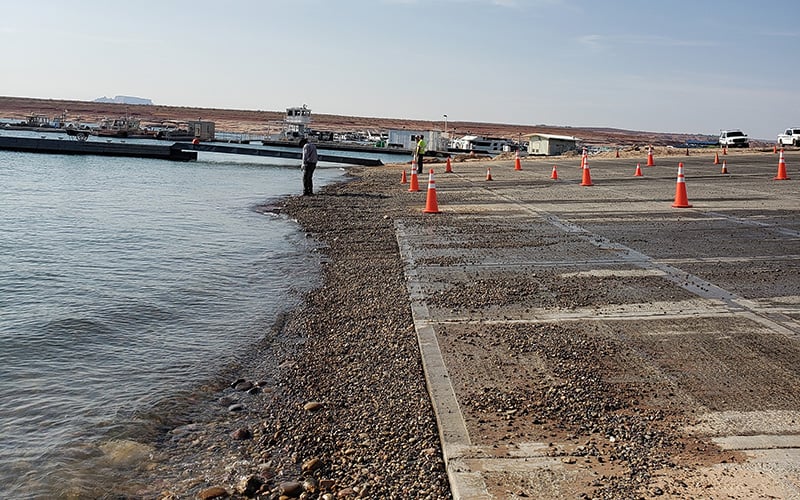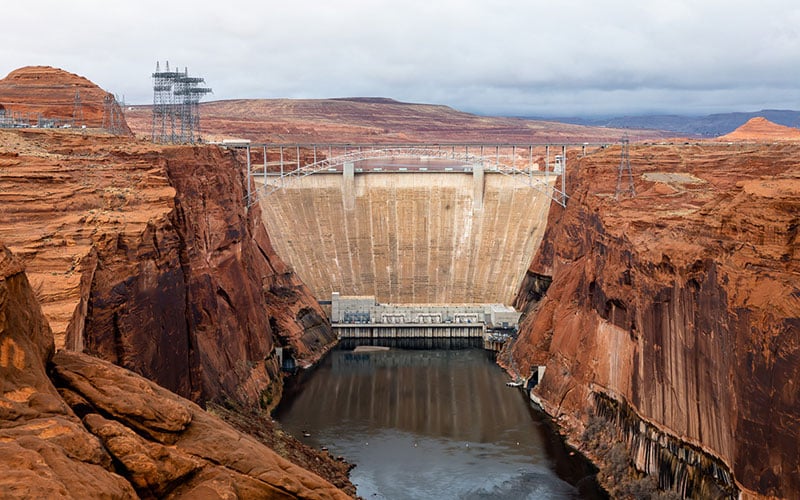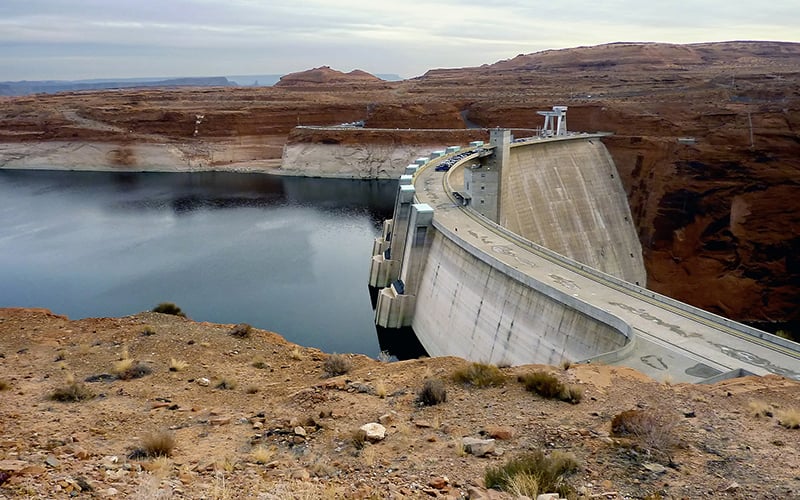
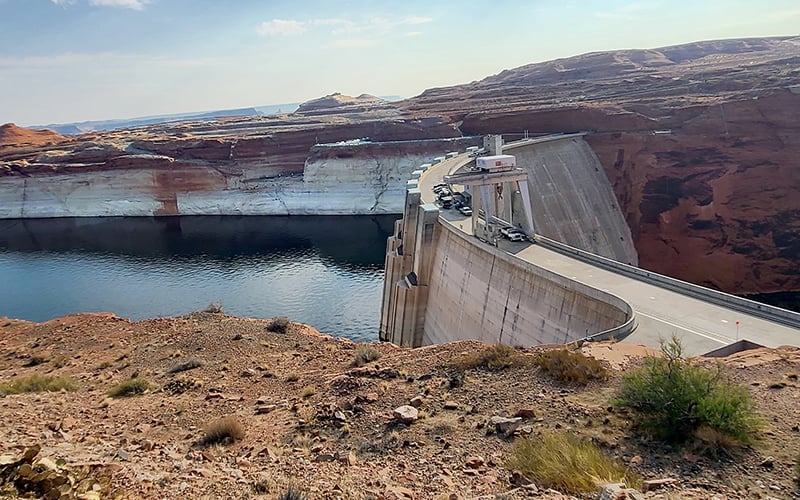
Lake Powell at the Glen Canyon Dam wall in a 2010 photo on the right, when the lake was at more typical levels, and on Aug. 18, 2021, as the lake was falling to historic lows. (Photos by U.S. Bureau of Reclamation)
WASHINGTON – Officials from the seven Colorado River basin states agreed Friday with a federal plan to sharply cut releases from Lake Powell, as both groups scramble to protect water supplies and power generation by propping up the lake’s level.
The states were responding to a proposal two weeks ago from Tanya Trujillo, an assistant secretary for water and science for the Interior Department, to withhold almost a half-million acre-feet to address “critically-low elevations over the next 24 months” at Lake Powell and Lake Mead.
“We definitely, collectively, agreed that some very significant and precise, also timely actions be taken,” said Tom Buschatzke, director of the Arizona Department of Water Resources, of the states’ letter.
Under Interior’s proposal, releases from Glen Canyon Dam would be reduced from 7.48 million acre-feet to 7 million acre-feet in fiscal 2022. That would reduce the risk of damage to the hydropower turbines at Lake Powell and protect water deliveries to Page and the Navajo Nation.
Buschatzke said that while local water delivery and power generation is an important consideration, the states agreed to the cuts now to protect “against very, very large reductions in water moving from Lake Powell to Lake Mead that would send Lake Mead to really critical elevations” that would require more severe action in the future.
While they agreed with the Lake Powell plan, the states said it is just a short-term solution to a long-term problem, and that more action will be needed.
“The mechanisms described in Assistant Secretary Trujillo’s letter and our agreement to those mechanisms are very creative,” Buschatzke said Friday. “They are short-term, however, and we need to continue to work on conserving more water through various programs.”
Federal officials conceded that more needs to be done, and that everyone is in uncharted territory as they grapple with historically low lake levels.
“Given our lack of actual operating experience in such circumstances since Lake Powell filled, these issues raise profound concerns regarding prudent dam operations, facility reliability, public health and safety, and the ability to conduct emergency operations,” Trujillo’s letter said.
The letter came weeks after the Bureau of Reclamation said that the elevation of Lake Powell had dipped below 3,525 feet. If the lake falls to 3,490 feet, there would not be enough water to operate the generators in Glen Canyon Dam, which provides power to Wyoming, Utah, Colorado, New Mexico, Arizona, Nevada and Nebraska.
In addition to reducing the amount of water released from Lake Powell, the upper basin states on Thursday proposed releasing an extra 500,000 acre-feet of water from Flaming Gorge reservoir upstream to further bolster Lake Powell.
While those efforts will help Lake Powell in the short term, they would also mean less water for Lake Mead downstream, which supplies water to the lower basin states of Arizona, Nevada and California. Lake Mead is already in a Tier 1 shortage, with lake levels below 1,065 feet, which triggered the drought contingency plan and resulted in a substantial cut to Arizona’s share of the Colorado River.
The moves are the latest response to a 20-year drought that scientists said recently may be the most severe in the region in more than 1,200 years. In addition to a lack of precipitation, hotter temperatures have led to drier soils that cannot hold water when it falls.
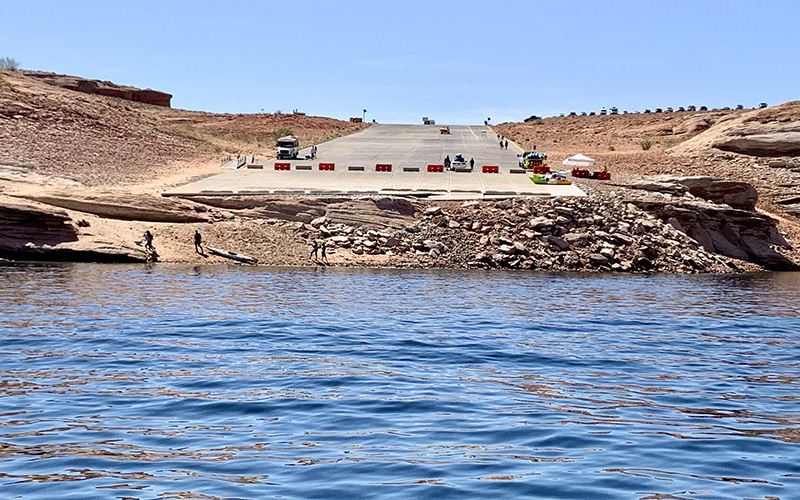
Kayakers access Lake Powell at the Antelope Point Public Launch Ramp, which was closed to motorized vehicles because of low water in this photo from March 2021. (Photo courtesy National Park Service)
And Trujillo’s letter said that current predictions indicate “that the effects of climate change will continue to adversely impact the basin” for some time to come.
Lake Powell has historically functioned as a vast “bank account” of water that can be drawn on during dry years, making the lake’s levels especially critical as the Southwest suffers through the drought, according to the Bureau of Reclamation website.
Sharon Megdal, director of the Water Resources Research Center at the University of Arizona, said the region is “living on deficit income” as far as its water resources are concerned. The states’ letter said Lake Powell’s “live storage” is currently only at 25%.
“Your savings account is not indefinite, infinite, right? And so eventually you get to the point, like we are with Lake Mead, that our savings account is being depleted,” she said.
The bureau already boosted releases from upstream reservoirs once this year to prop up Lake Powell, and reduced releases from it by 350,000 acre-feet. The latest proposed reduction in releases should “delay or avoid operational conditions below the critical elevations” for now, Trujillo said, but she said it is only a temporary fix.
“We fully realize that absent a change in the recent hydrological conditions, we may not be able to avoid such (adverse) operations,” her letter said. “This reality reinforces the need for the Basin States, and all entities in the Basin, to prioritize work to further conserve and reduce use of Colorado River water to stabilize the System’s reservoirs.”
The immediate concern, however, is Lake Powell, which has not been this low since it was filled in the 1960s. If it falls below 3,490 feet. “the western electrical grid would experience uncertain risk and instability, and water and power supplies to the West and Southwestern United States would be subject to increased operational uncertainty,” Trujillo said.
“The consequences are more severe for Lake Powell now, including for Page,” said Kathy Jacobs, director of the Center for Climate Adaptation Science and Solutions at the UArizona.
Even with a reduction in releases from Lake Powell, Trujillo said more will need to be done to reduce the risk of the lake dropping to the point that Glen Canyon Dam could no longer generate power.
“We’re in a situation where emergency action is required to ensure the integrity of Glen Canyon Dam and Lake Powell and the whole Colorado river system,” said Anne Castle, senior fellow at the Getches-Wilkinson Center for Natural Resources, Energy, and the Environment at the University of Colorado Law School.
Jacobs said there is no time to waste.
“If we fail to come up with a shortage sharing plan that protects the users in the basin and the environment, then the consequences are likely to be severe,” she said.

